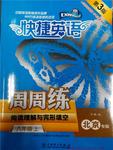题目内容
The trees arrived by post, a half-open parcel. They were thin and straight, rather like arrows but with shiny leaves at one end and muddy roots at the other. Terry and his father took them down the garden and planted them in their prepared places. Terry had great hopes of the middle tree, now set in the memorial spot where Herry, his cat, run over, had been laid to rest a year before. The pine trees made an avenue down one side of the garden, where there was already a fifteen-foot stone wall between the garden and the back-yards of the Jenkins Street houses.
“Why do we want a row of trees as well as a wall?”Terry asked his father.
His father said,“For privacy. These trees grow very thickly.”
His father's love of privacy often puzzled Terry, who was not one to keep himself to himself, but he could see part of the point here. The houses in Jenkins Street were on higher ground. His friend Leslie lived in number twelve, and Leslie had only to stand on a box to see right over the wall.
“Will the trees grow higher than the wall?” Terry asked then.
“Oh yes, twice as high if not more. It'll take a few years but they'll grow.”
So they were going to have nine trees thirty feet tall, to keep them from being overlooked. Terry wondered why this was so desirable. He said, “Our garden is very pretty. Why can't we let the people over the wall see it? That wouldn't be showing off, would it?”
“No, I don't think it would be,” his father said. “Yet some people might feel a bit less happy if they can always see a good thing that isn't theirs. We don't want to be the cause of any jealousy if we can help it.”
This consideration for other people's feelings must be a grown-up thing, Terry thought. It was not his idea of how to run things. He said, “These trees? It seems a lot of trouble to go just to stop people being jealous of us.”
His father looked at him. “It isn't much trouble, Terry,” he said. “These trees will grow without help from us. They'll be beautiful. And listen to them. You can already hear them whispering to us in the wind.”
(1) The passage mainly deals with the topic of ________.
[ ]
A.protection of environment
B.relationship between neighbours
C.generation gap
D.cause of jealousy
(2) Part of the garden is called a memorial spot because ________.
[ ]
A.a cat was buried there
B.Herry had been run over there
C.Terry's own tree was planted there
D.it was in front of Leslie's house
(3) The word “privacy” in the third paragraph most probably means “________”.
[ ]
A.to keep away from thieves
B.to avoid being disturbed
C.to keep the air fresh
D.to avoid being polluted
(4) Terry's father was a man who ________.
[ ]
A.was proud of his garden and liked showing it off
B.was very sociable towards his neighbours
C.preferred to keep himself to himself
D.felt jealous of the people in Jenkins street
(5) What did Terry not approve of?
[ ]
A.Letting outsiders see the garden.
B.The height of the houses in Jenkins Street.
C.The way Leslie managed to look over the wall.
D.His father's concern for other people's feelings.

 快捷英语周周练系列答案
快捷英语周周练系列答案